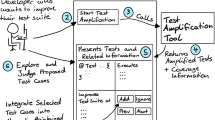Abstract
In today’s software industry, systems are constantly changing. To maintain their quality and to prevent failures at controlled costs is a challenge. One way to foster quality is through thorough and systematic testing. Therefore, the definition of adequate tests is crucial for saving time, cost and effort. This paper presents a framework that generates software test cases automatically based on user interaction data. We propose a data-driven software test generation solution that combines the use of frequent sequence mining and Markov chain modeling. We assess the quality of the generated test cases by empirically evaluating their coverage with respect to observed user interactions and code. We also measure the plausibility of the distribution of the events in the generated test sets using the Kullback-Leibler divergence.
Access this chapter
Tax calculation will be finalised at checkout
Purchases are for personal use only
Similar content being viewed by others
References
Ajouli, A., Henchiri, K.: MODEM: an UML profile for MODEling and Predicting software Maintenance before implementation (2019). https://doi.org/10.1109/ICCISci.2019.8716421
Choetkiertikul, M., Dam, H.K., Tran, T., Ghose, A.: Predicting delays in software projects using networked classification (T). In: 2015 30th IEEE/ACM International Conference on Automated Software Engineering (ASE), pp. 353–364 (2015). https://doi.org/10.1109/ASE.2015.55
Grossman, L.: Metric math mistake muffed mars meteorology mission (2010). https://www.wired.com/2010/11/1110mars-climate-observer-report/
Kelion, L.: Fatal a400m crash linked to data-wipe mistake. BBC (2015). https://www.bbc.com/news/technology-33078767
Babar, M.A., Brown, A.W., Mistrik, I.: Agile Software Architecture: Aligning Agile Processes and Software Architectures, 1st edn. Morgan Kaufmann Publishers Inc., San Francisco (2013)
Florea, R., Stray, V.: The skills that employers look for in software testers. Softw. Qual. J. 27, 1449–1479 (2019)
Anderson, B.: Best automation testing tools for 2019 (top10 reviews), October 2017. https://medium.com
Last, M., Friedman, M., Kandel, A.: Using data mining for automated software testing. Int. J. Software Eng. Knowl. Eng. 14(4), 369–393 (2004). https://doi.org/10.1142/S0218194004001737
Giudice, D.L.: How AI Will Change Software Development And Applications Key takeaways (2016)
Isabella, A., Retna, E.: Study paper on test case generation for GUI based testing. CoRR, vol. abs/1202.4527 (2012). http://arxiv.org/abs/1202.4527
Conroy, K., Grechanik, M., Hellige, M., Liongosari, E., Xie, Q.: Automatic test generation from GUI applications for testing web services, pp. 345–354, October 2007
Zhou, K., Wang, X., Hou, G., Wang, J., Ai, S.: Software reliability test based on Markov usage model. JSW 7(9), 2061–2068 (2012). https://doi.org/10.4304/jsw.7.9.2061-2068
Fournier-Viger, P., Gomariz, A., Campos, M., Thomas, R.: Fast vertical mining of sequential patterns using co-occurrence information, May 2014
Ayres, J., Flannick, J., Gehrke, J., Yiu, T.: Sequential pattern mining using a bitmap representation, July 2002
Gutjahr, W.J.: Software dependability evaluation based on Markov usage models. Perform. Eval. 40(4), 199–222 (2000). https://doi.org/10.1016/S0166-5316(99)00052-8
Kullback, S.: Information Theory and Statistics. Wiley, New York (1959)
Acknowledgment
This work is financed by the Northern Regional Operational Program, Portugal 2020 and the European Union, through the European Regional Development Fund (https://www.rtcom.pt/wordpress/rute-randtech-update-and-test-environment/). Also, this work is financed by National Funds through the Portuguese funding agency, FCT - Fundação para a Ciência e a Tecnologia, within project UIDB/50014/2020.
Author information
Authors and Affiliations
Corresponding author
Editor information
Editors and Affiliations
Rights and permissions
Copyright information
© 2020 Springer Nature Switzerland AG
About this paper
Cite this paper
Oliveira, A. et al. (2020). Sequence Mining for Automatic Generation of Software Tests from GUI Event Traces. In: Analide, C., Novais, P., Camacho, D., Yin, H. (eds) Intelligent Data Engineering and Automated Learning – IDEAL 2020. IDEAL 2020. Lecture Notes in Computer Science(), vol 12490. Springer, Cham. https://doi.org/10.1007/978-3-030-62365-4_49
Download citation
DOI: https://doi.org/10.1007/978-3-030-62365-4_49
Published:
Publisher Name: Springer, Cham
Print ISBN: 978-3-030-62364-7
Online ISBN: 978-3-030-62365-4
eBook Packages: Computer ScienceComputer Science (R0)




